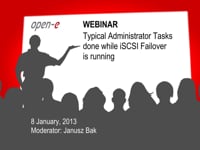Article
Disaster Recovery for Fibre Channel with Synchronous Replication
Date: Jun 17, 2015
Disaster Recovery is one of the most essential strategies for securing lost data against disasters. It includes all processes and procedures that are performed in order to prevent large failures and to avoid the consequences by keeping copies of data. With a consistent strategy, you are able to quickly recover business-critical files and applications of your IT infrastructure - ensuring business continuity and minimization of data loss.

